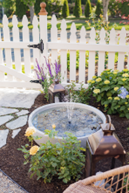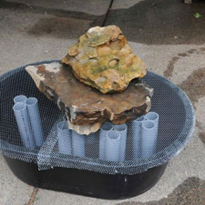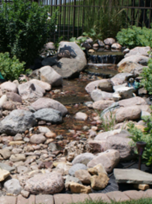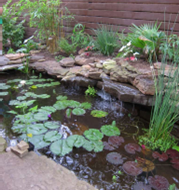Who doesn’t enjoy the soothing sound and appearance of running water? It can be very easy to bring that into your yard, garden, or even onto your deck or patio. The sight and sound of moving water will make you feel cooler and can help block out road noise. In addition, you can attract many types of wildlife from dragonflies and frogs to birds and small mammals. Think about adding such a lovely, inexpensive element to your landscape.

There are many types of water features you can create yourself, sometimes simply out of objects you have around your home. You can also purchase a fully operational feature if you choose. Not all of them require digging or hiring an electrician.
Containers with still water, as in a birdbath, can be as simple as a ceramic pot, a rubber or galvanized tub, a horse trough, or an old bathtub. No need for running water or electricity. If it’s small and light enough, it can sit on a deck. Heavier containers should be placed on level ground. Add a few plants around it to make it look natural, and it can make a nice reflecting pool for a garden. Stack a few rocks to create a shallow area for birds to drink and bathe. Add a few water plants and you have a water garden. You can also add one or two goldfish for movement. Just remember with a shallow container that will freeze, to bring the fish inside for the winter. Don’t dump them in a stream. Some containers will break if they freeze, so bring them inside or drain the water out for winter. Tip them upside down so they don’t collect rainwater and freeze.

Many water features can have flowing water with the help of a solar or small electric pump. There are simple floating solar fountains for $10-$20 that can turn a bird bath or other container into a fountain. Be aware that the wind might blow the water out which can cause the pump to burn up. To prevent that from happening, lower the height of the fountain spray, or enlarge the diameter of the container. Look for a pump that automatically shuts off if it runs dry. Moving water does not allow mosquitoes to lay eggs.
Another type of small water feature utilizes a hidden reservoir where the water gathers and is pumped around again. Bubblers and small floating fountains are frequently set over buried pot reservoirs where a pump recirculates the water. Since these don’t require a lot of power to lift the water a long way, a solar pump is adequate. The hidden reservoir is usually a heavy plastic tub or bucket covered with supported hardware cloth that in turn supports the above water feature. Bubblers can be a few stacked rocks with the waterline from the pump causing water to bubble up and flow over into the reservoir. A fountain is a taller version of this idea of recirculating water. A single larger rock can have a hole drilled through it to accept the waterline and bubble out the top.

Waterfalls can be more elaborate versions of bubblers that can sit on the hidden reservoir or have a stream bed flowing downhill with the reservoir at the end. Streambeds require a waterproof liner and a stronger pump to recirculate the water. The reservoir can be hidden, as above, creating a disappearing stream, or flow into an excavated, lined pond.
Ponds can be an extension of another water feature with a recirculating pump or stand alone. They can be fairly small, only a few feet across or as large as a farm pond. Unless you have heavy clay that can be compacted to hold the water, ponds need a PVC or similar liner with edges that can be held down and covered with decorative rocks, pavers, or bricks. There are also preformed small ponds that can be left in the ground over winter. A pump sized to the pond can aerate the water.
Before you install a water feature, there are several things to consider: placement, safety, water and electricity source, lighting, having plants and fish.
Place your water feature close to the house or outside seating where you can easily enjoy it. Consider the weight of a filled tub or pot before putting it on your deck. Water is heavy. If you want to grow water plants, place your water feature in the sun. Try to avoid areas under large trees as the fall leaves will be a problem unless you place a screen over the water. If putting in a rigid container or liner, make sure the ground it sits on is level to avoid cracking. If the area you dig out for a liner has stones or tree roots, line it with sand as cushioning to avoid punctures.

Water features that are shallow re-circulators or that have hidden reservoirs pose no hazards to children. Supervision is needed around deeper ponds.
Consider the availability of electricity and water. Plan to bury the wires and pipes and use ground fault connectors to avoid injury. You won’t have to worry about either of those items if you simply use a garden hose to fill and clean, and a solar pump. Your pump can also be used to empty the water, if necessary.
If your feature is in the sun, plan to have enough floating plants such as water lettuce, water hyacinth, or waterlilies to cover 50-75% of the water surface to prevent a buildup of algae. Adding fish to your pond will prevent mosquitoes. Use common goldfish as koi get too large. If you want the fish to be able to remain in the pond over winter, the depth of at least part of it should be 48-inches. Start with only a few fish as they can deplete the oxygen in the water quickly if it gets too hot. Adding a pump to aerate the water will add more oxygen, as will live plants. There is usually no need to feed the fish and doing so can foul the water. Mechanical or biological filters shouldn’t be necessary if the ratio of plants to fish is high enough. Don’t feed the fish in the winter as there will be no growing plants to use the waste nutrients.
Remember, you can start with a small simple water feature very easily and inexpensively. You will enjoy anything you create that adds the soothing sight and should of water to your landscape. Include live plants around and in it to create a true ecosystem for all to enjoy.
For more information, visit: Penn State Extension, https://extension.psu.edu/tips-for-creating-a-water-garden; Oklahoma State Extension, https://extension.okstate.edu/fact-sheets/water-gardens.html;
Cornell Cooperative Extension, https://ccenassau.org/horticulture/water-gardens.




